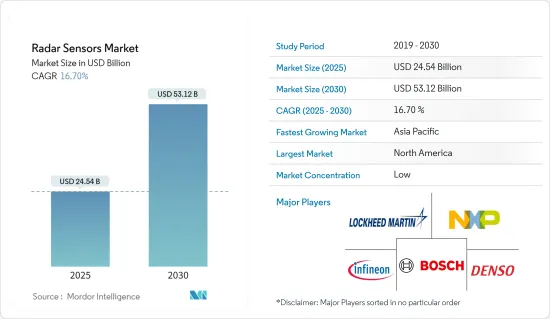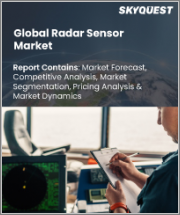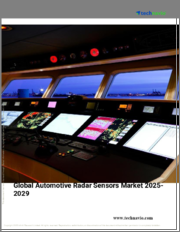
|
시장보고서
상품코드
1640703
레이더 센서 - 시장 점유율 분석, 산업 동향과 통계, 성장 예측(2025-2030년)Radar Sensors - Market Share Analysis, Industry Trends & Statistics, Growth Forecasts (2025 - 2030) |
||||||
■ 보고서에 따라 최신 정보로 업데이트하여 보내드립니다. 배송일정은 문의해 주시기 바랍니다.
레이더 센서 시장 규모는 2025년에 245억 4,000만 달러로 추정되며, 예측 기간(2025-2030년)의 CAGR은 16.7%로, 2030년에는 531억 2,000만 달러에 달할 것으로 예측됩니다.

주요 하이라이트
- 자동화의 급속한 진전, 자율 주행 개발, 인더스트리 4.0의 진전에 의해 선진적 안전성과 제어를 위한 물체와 동작 탐지 요구가 높아지고 있습니다.
- 자동차 부문은 안전, 편리성 및 엔터테인먼트성을 향상시키기 위해 기술적 전환기를 맞이하고 있으며, 레이더 센서에는 충분한 비즈니스 기회가 있습니다. 레이더 센서의 요구는 드론, 자율주행차, ADAS(선진운전지원시스템) 등 센서를 많이 사용하는 부문의 개발에 의해 가속화되고 있습니다.
- 레이더 센서의 기술 향상은 시장 성장에 큰 영향을 미칩니다. 레이더 센서 시장에서 주요 초점이 될 것으로 예상되는 밀리미터파(mm-Wave) 기술의 채택은 센서의 능력과 효율을 크게 향상시키고 있습니다.
- 레이더 센서는 특히 조명, 에어컨, 위생 시스템, 자동문의 비접촉 제어, 알람, 입퇴실 관리, 추적 용도 등의 보안 시스템을 제공하여 스마트 홈 시장에 필수적인 요소가 되고 있습니다.
- 항공우주 부문에서는 항공기처럼 멀리 떨어진 물체의 위치와 속도를 감지하여 안전과 보안 기준을 보장하기 위해 레이더 센서가 채택됩니다. 이러한 센서는 정확한 거리 측정을 통해 민간 항공기 및 군용 항공기의 안전성과 효율성을 향상시키는 데 도움이 됩니다. 또한 적기 공중 모니터링 시스템에도 사용되어 적군의 침입을 감지하거나 기타 의심스러운 활동을 추적합니다.
- 레이더 센서는 미사일 유형, 궤도 및 표적에 대한 자세한 정보를 제공하기 위해 항공 시스템에서 사용되며 미사일 공격의 사전 감지에도 도움이 됩니다. 또한 항공우주 및 방위기기나 환경을 감지하여 장애물을 검출하는 기기의 진보가 레이더 센서 시장의 성장을 뒷받침하고 있습니다.
- 그러나 레이더 센서는 시야가 좁고 가속도 차이가 있는 경우 탐지가 제한되는 점은 시장 성장에 대한 주요 과제입니다.
레이더 센서 시장 동향
자동차 부문이 큰 성장을 이룰 전망
- 자동차 레이더는 차량 근처에 있는 물체의 속도와 범위를 감지하는 데 중요한 역할을 합니다. Scotiabank에 따르면 세계 자동차 판매량은 2022년 약 6,730만 대에서 2023년에는 약 7,530만 대로 증가했습니다.
- 레이더 센서는 자율 주행 환경에서 중요한 역할을 합니다. ADAS 차량에는 충돌 회피, 자동 주차, 차내 모니터링, 협조 운전, 집단 상황 인식 등 여러 안전 및 편의성 용도를 담당하는 여러 레이더가 탑재되어 있습니다.
- 자율주행차 생태계의 AI도 시장을 견인합니다. 디지털 레이더는 최신 컴퓨터 비전 알고리즘과 함께 사용되어 AI 기능을 향상시키고 물체의 감지 및 분류를 용이하게 합니다.
- 이러한 디지털 레이더는 첨단 자동 운전을 실현하여 좌회전 보조, 사각 모니터링, 자동 긴급 브레이크, 어댑티브 크루즈 컨트롤, 정체구간 주행보조, 고속도로 주행보조 등의 첨단 기능을 전개할 수 있습니다. 5G 밀리미터파 통신의 효율성을 대폭 향상시키기 위해 첨단 아날로그 기술을 기반으로 5G 액티브 패시브 반사 어레이를 제공하는 새로운 유형의 자동차 레이더 시스템이 개발되었습니다.
북미가 레이더 센서 시장에서 큰 점유율을 차지
- 하이엔드 방위 기기, 스마트폰 보급, 자율주행차, 소비자용 전자기기가 미국의 레이더 센서 시장의 큰 촉진요인이 되고 있습니다. 이 지역은 세계에서 가장 방위 예산이 많기 때문에 FMCW 용도, 특히 단거리 용도가 점차 늘어나고 있습니다.
- 이 지역에서는 스마트 그리드, 스마트 홈, 인텔리전트 교통, 스마트 수도망, 레이더 센서 기술을 이용한 인프라 등 새로운 신기술이 개척되고 있습니다. 레이더 센서 기술의 개발은 이러한 부문에서 새로운 이용 사례를 개척하고 공급업체에게 성장 기회를 제공할 것으로 기대되고 있습니다.
- 레이더 센서 수요는 휴대폰에 새로운 기능을 탑재하는 제조업체가 늘어나면서 스마트폰의 높은 보급률에 의해서도 견인될 것으로 예상됩니다. GSMA는 2025년 말까지 북미 휴대전화 연결의 거의 3분의 2가 5G를 통해 이루어지며 약 2억 7,000만 건에 달할 것으로 예측했습니다.
- 레이더 센서가 제공하는 이점을 고려하여 많은 정부기관과 민간단체들이 이러한 센서의 효율을 더욱 높이기 위한 연구개발을 강화하고 있어 시장에 긍정적인 영향을 미칠 것으로 예상됩니다.
레이더 센서 산업 개요
레이더 센서 시장은 다양한 주요 진출기업들이 존재하기 때문에 세분화됩니다. 주요 진출기업으로는 Robert Bosch Gmbh, Lockheed Martin Corporation, NXP Semiconductors, Infineon Technologies, STMicroelectronics NV, Continental AG 등이 있습니다.
- 2024년 1월 NXP Semiconductors NV는 자동차용 레이더 원칩 제품군의 확장 제품을 출시했습니다. 새로운 SAF86xx는 고성능 레이더 트랜시버, 멀티 코어 레이더 프로세서, MACsec 하드웨어 엔진을 원활하게 통합하여 자동차 이더넷을 통해 최첨단 보안 데이터 통신을 실현합니다. 이 종합적인 시스템 솔루션은 NXP의 S32 고성능 프로세서, 차량 탑재 네트워크 연결성 및 전력 관리 기능과 결합하여 고급 소프트웨어 기반 레이더 기술을 구축합니다.
- 2023년 11월, Lockheed Martin은 미국 공군이 뉴욕 외곽지역에 있는 회사 시설에서 수개월에 걸친 내부 테스트와 조정을 거쳐 선진 TPI-4 레이더의 추가 평가를 개시한다고 발표하였습니다. 이 소프트웨어 기반 센서는 소형 무인 항공기에서 제트기, 탄도 미사일에 이르기까지 모든 것을 감지 및 추적 가능하며 3차원 원정 장거리 레이더(3DELRR) 프로젝트의 일환으로 수십년전 개발된 TPS-75 레이더를 대체할 예정입니다.
기타 혜택
- 엑셀 형식 시장 예측(ME) 시트
- 3개월 간 애널리스트 서포트
목차
제1장 서론
- 조사의 전제조건과 시장 정의
- 조사 범위
제2장 조사 방법
제3장 주요 요약
제4장 시장 인사이트
- 시장 개요
- 산업 밸류체인 분석
- 산업의 매력 - Porter's Five Forces 분석
- 공급기업의 협상력
- 구매자의 협상력
- 신규 진입업자의 위협
- 대체 제품의 강도
- 경쟁 기업간 경쟁 관계
- COVID-19의 영향과 기타 거시 경제 요인이 시장에 미치는 영향
제5장 시장 역학
- 촉진요인
- 국가 안보에 대한 요구 증가
- 자율주행차 증가와 보안안전요구 증가
- 시장의 과제
- 높은 연구 개발비와 유지 보수 비용
제6장 시장 세분화
- 유형별
- Imagen 그레이더
- 비이미지 그레이더
- 범위별
- 단거리 레이더 센서
- 중거리 레이더 센서
- 장거리 레이더 센서
- 최종 사용자별
- 자동차
- 보안 모니터링
- 산업용
- 환경 및 기상 모니터링
- 교통 모니터링
- 기타
- 지역별
- 북미
- 유럽
- 아시아
- 호주 및 뉴질랜드
- 라틴아메리카
- 중동 및 아프리카
제7장 경쟁 구도
- 기업 프로파일
- Robert Bosch GmbH
- Lockheed Martin Corporation
- NXP Semiconductors NV
- Denso Corporation
- Infineon Technologies AG
- Continental AG
- Hella KGaA Hueck & Co.
- Delphi Automotive LLP
- Baumer Group
- Smart Microwave Sensors GmbH
- InnoSenT GmbH
- Veoneer Inc.
- STMicroelectronics NV
- Hitachi Automotive Systems(Hitachi Ltd)
- Banner Engineering Corporation
제8장 투자 분석
제9장 시장의 미래
CSM 25.02.17The Radar Sensors Market size is estimated at USD 24.54 billion in 2025, and is expected to reach USD 53.12 billion by 2030, at a CAGR of 16.7% during the forecast period (2025-2030).

Key Highlights
- Due to rapidly advancing automation, developments in autonomous driving, and the progression of Industry 4.0, the need for presence and motion detection for advanced safety and control is increasing.
- The automotive sector is undergoing a technological transition to improve safety, comfort, and entertainment and has ample opportunities for radar sensors. The need for radar sensors is being accelerated by the development of sensor-rich applications such as drones, autonomous cars, and advanced driver assistance systems.
- Technological improvements in radar sensors are a significant factor impacting market growth. The introduction of millimeter-wave (mm-Wave) technology, which is expected to become a primary focus in the radar sensors market, significantly improves sensor capabilities and efficiency.
- Radar sensors have become an integral part of the smart home market, particularly offering contactless control for lighting, air conditioning, sanitary systems, and automatic doors, as well as security systems such as alarms, access control, and tracking applications.
- In the aerospace sector, radar sensors are employed to ensure safety and security standards by detecting the position and velocity of an object found at a distance, such as an aircraft. These sensors help enhance the safety and efficiency of commercial and military aircraft through exact distance measurements. It is also used in airborne surveillance systems of spy planes to detect the surprising arrival of enemy forces and track other dubious activities.
- Radar sensors are used in aviation systems to deliver detailed information regarding the missile type, trajectory, and target, and they also help in the prior detection of missile attacks. Additionally, advancements in aerospace and defense equipment and instruments to sense the environment and detect obstacles are boosting the growth of the radar sensors market.
- However, some of the main challenges to market growth are factors like a limited field of vision and limitations in detection when there is an acceleration difference.
Radar Sensors Market Trends
The Automotive Sector is Expected to Witness Significant Growth
- Automotive radar plays a vital role in detecting the speed and range of objects in the car's proximity. According to Scotiabank, car sales worldwide grew to around 75.3 million units in 2023, up from around 67.3 million units in 2022.
- Radar sensors play a crucial role in the autonomous driving environment. An ADAS vehicle has multiple radars covering multiple safety and comfort applications, like crash avoidance, self-parking, in-cabin monitoring, cooperative driving, and collective situational awareness.
- AI in the autonomous vehicle ecosystem also drives the market. Digital radar is used with a modern computer vision algorithm to improve AI functionality, making object detection and classification easier.
- These digital radars can deliver a high degree of automatic driving and deploy sophisticated features, such as left turn assist, blindspot monitoring, automatic emergency braking, adaptive cruise control, traffic jam pilot, or highway pilot. In order to significantly increase the efficiency of 5G millimeter-wave communications, a new type of automotive radar system is being developed based on advanced analog technology and providing 5G active and passive reflection arrays.
North America Holds a Significant Share of the Radar Sensors Market
- High-end defense applications, smartphone penetration, autonomous vehicles, and consumer electronics devices are significant growth drivers for the US radar sensors market. As the region has the highest defense budget in the world, the increase in FMCW applications, particularly short-range applications, is gaining momentum.
- New and emerging technologies, like smart grids, smart homes, intelligent transport, smart water networks, and infrastructure with radar sensor technology, are being pioneered in the region. The development of radar sensor technology is expected to open up new use cases in these areas, creating growth opportunities for suppliers.
- The demand for radar sensors is also expected to be driven by the high penetration of smartphones as more manufacturers incorporate new features into their mobile phones. GSMA estimates that almost two-thirds of North America's cellular connections will be 5G by the end of 2025, with approximately 270 million contacts.
- Given the benefits that radar sensors provide, a number of government and commercial organisations are increasing their research and development efforts to further increase the efficiency of these sensors, which is expected to positively impact the market.
Radar Sensors Industry Overview
The radar sensors market is fragmented due to the presence of many significant players. Some prominent players include Robert Bosch Gmbh, Lockheed Martin Corporation, NXP Semiconductors, Infineon Technologies, STMicroelectronics NV, and Continental AG.
- January 2024: NXP Semiconductors NV launched an extension to its automotive radar one-chip family. The new SAF86xx seamlessly integrates a high-performance radar transceiver, a multi-core radar processor, and a MACsec hardware engine to facilitate cutting-edge secure data communication via Automotive Ethernet. This comprehensive system solution lays the groundwork for advanced, software-defined radar technology when coupled with NXP's S32 high-performance processors, vehicle network connectivity, and power management capabilities.
- November 2023: Lockheed Martin Corporation announced that the US Air Force would launch its advanced TPY-4 radar for further evaluation following months of internal testing and tweaks at company facilities in rural New York. The software-defined sensor, capable of detecting and tracking everything from small drones to jets to ballistic missiles, is slated to replace the decades-old TPS-75 radar as part of the Three-Dimensional Expeditionary Long Range Radar effort, or 3DELRR.
Additional Benefits:
- The market estimate (ME) sheet in Excel format
- 3 months of analyst support
TABLE OF CONTENTS
1 INTRODUCTION
- 1.1 Study Assumptions and Market Definition
- 1.2 Scope of the Study
2 RESEARCH METHODOLOGY
3 EXECUTIVE SUMMARY
4 MARKET INSIGHTS
- 4.1 Market Overview
- 4.2 Industry Value Chain Analysis
- 4.3 Industry Attractiveness - Porter's Five Forces Analysis
- 4.3.1 Bargaining Power of Suppliers
- 4.3.2 Bargaining Power of Buyers
- 4.3.3 Threat of New Entrants
- 4.3.4 Intensity of Substitute Product
- 4.3.5 Threat of Competitive Rivalry
- 4.4 Impact of COVID-19 Aftereffects and Other Macroeconomic Factors on the Market
5 MARKET DYNAMICS
- 5.1 Market Drivers
- 5.1.1 Increasing Need for National Security
- 5.1.2 Increasing Number of Autonomous Cars and Focus on Security and Safety Needs
- 5.2 Market Challenges
- 5.2.1 High R&D and Maintenance Costs
6 MARKET SEGMENTATION
- 6.1 By Type
- 6.1.1 Imaging Radar
- 6.1.2 Non-Imaging Radar
- 6.2 By Range
- 6.2.1 Short-range Radar Sensor
- 6.2.2 Medium-range Radar Sensor
- 6.2.3 Long-range Radar Sensor
- 6.3 By End User
- 6.3.1 Automotive
- 6.3.2 Security and Surveillance
- 6.3.3 Industrial
- 6.3.4 Environment and Weather Monitoring
- 6.3.5 Traffic Monitoring
- 6.3.6 Other End Users
- 6.4 By Geography
- 6.4.1 North America
- 6.4.2 Europe
- 6.4.3 Asia
- 6.4.4 Australia and New Zealand
- 6.4.5 Latin America
- 6.4.6 Middle East and Africa
7 COMPETITIVE LANDSCAPE
- 7.1 Company Profiles
- 7.1.1 Robert Bosch GmbH
- 7.1.2 Lockheed Martin Corporation
- 7.1.3 NXP Semiconductors NV
- 7.1.4 Denso Corporation
- 7.1.5 Infineon Technologies AG
- 7.1.6 Continental AG
- 7.1.7 Hella KGaA Hueck & Co.
- 7.1.8 Delphi Automotive LLP
- 7.1.9 Baumer Group
- 7.1.10 Smart Microwave Sensors GmbH
- 7.1.11 InnoSenT GmbH
- 7.1.12 Veoneer Inc.
- 7.1.13 STMicroelectronics NV
- 7.1.14 Hitachi Automotive Systems (Hitachi Ltd)
- 7.1.15 Banner Engineering Corporation
8 INVESTMENT ANALYSIS
9 FUTURE OF THE MARKET
샘플 요청 목록



















